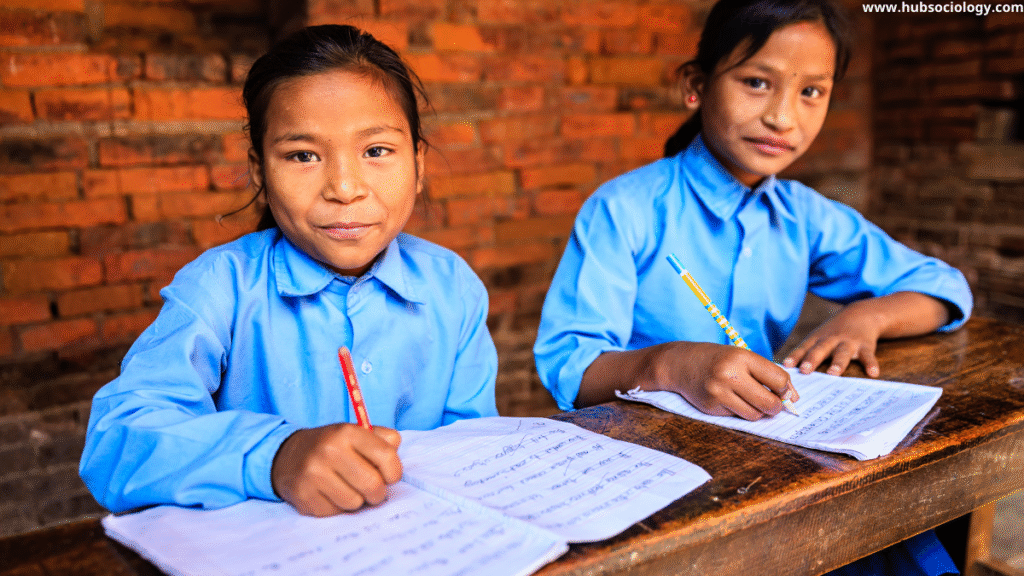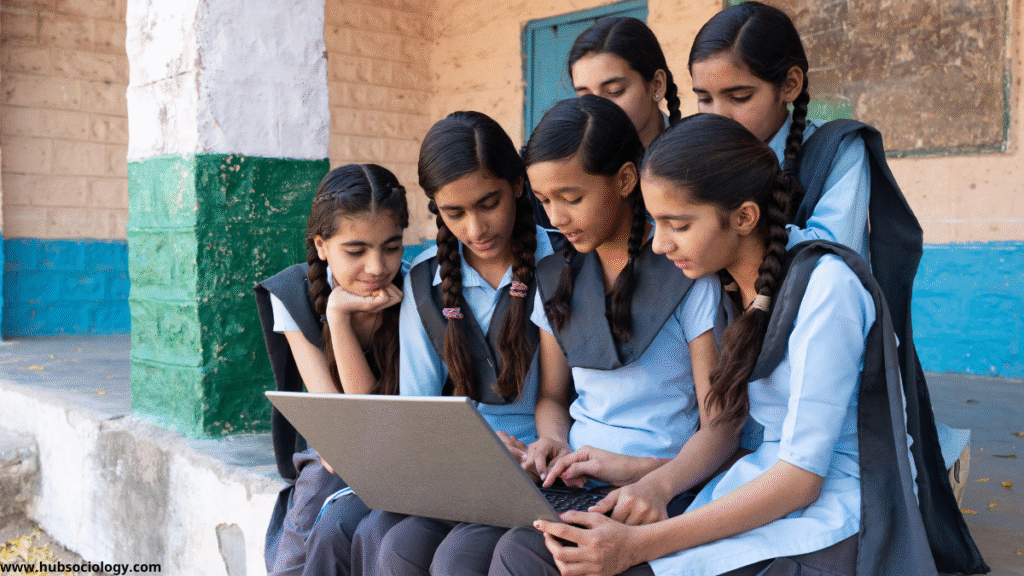Introduction on Objectives of Educational Policies
Education in India has always been more than a means of acquiring knowledge—it is a vital social institution that shapes identity, culture, and development. Through education, societies reproduce values, promote equality, and adapt to social change. India’s Objectives of Educational Policies since independence have reflected this sociological role, attempting to balance tradition with modernity, equality with excellence, and national integration with globalization. The National Policies on Education (NPE) of 1968, 1986, and 2022 represent key milestones in India’s educational evolution, each addressing the socio-political context of its time.
Analyzing Objectives of Educational Policies sociologically reveals how education serves as both an instrument of social transformation and a reflection of changing national priorities.

Table of Contents on Objectives of Educational Policies
1. National Policy on Education, 1968: Democratizing Knowledge and Promoting Unity
The NPE of 1968, based on the recommendations of the Kothari Commission (1964–66), was India’s first comprehensive education policy. Post-independence India was struggling with illiteracy, regional disparities, and social stratification. The policy’s primary objective was to create a national system of education that would promote social cohesion, modernization, and equality.
Sociological Objectives:
- National Integration and Unity:
The 1968 policy emphasized the role of education in fostering national identity amidst India’s cultural diversity. The introduction of the “three-language formula” was a sociological strategy to promote linguistic pluralism and unity, encouraging respect for regional languages while strengthening Hindi and English for national and global communication. - Equality of Educational Opportunity:
Recognizing the caste, class, and gender inequalities prevalent in Indian society, the policy aimed to make education accessible to all. It called for special measures to expand educational facilities for scheduled castes, scheduled tribes, and women, thereby attempting to reduce social stratification through education. - Educational Modernization:
The policy linked education with modernization by emphasizing science and technology, reflecting India’s ambition to industrialize and modernize post-independence. Sociologically, it signified the transition from traditional, religious education systems to a secular, rational, and scientific outlook. - Moral and Cultural Values:
While promoting modernization, the policy stressed value education to preserve moral and spiritual heritage. This dual focus represented the sociological tension between tradition and modernity—an effort to modernize without losing cultural roots.
In summary, the 1968 policy viewed education as a tool for nation-building and social mobility. However, its implementation faced challenges due to lack of resources and regional disparities, leading to growing demands for reform by the 1980s.
2. National Policy on Education, 1986: Education for Equality and Empowerment
The NPE of 1986, formulated under Prime Minister Rajiv Gandhi, reflected the changing socio-economic landscape of India during the 1980s—a period marked by technological growth, women’s movements, and demands for social justice. This policy took a more egalitarian and inclusive approach, recognizing education as a means to achieve social justice, empowerment, and national development.
Sociological Objectives:
- Education as an Instrument of Social Change:
The policy explicitly stated that education should act as an agent of social transformation, reducing inequalities of caste, class, and gender. It recognized that marginalized groups had been excluded from the educational process and sought to integrate them into mainstream education. - Focus on Equality and Empowerment:
The 1986 policy prioritized Education for Equality, especially for women, SCs, STs, and other backward classes. Programs like the Mahila Samakhya were launched to promote women’s empowerment through education, marking a sociological shift toward gender-inclusive development. - Universalization of Elementary Education:
The policy stressed universal access and retention at the primary level, aiming to eliminate illiteracy and school dropouts. From a sociological perspective, this was a step toward equalizing life chances across social groups, reducing intergenerational poverty. - Curriculum and Value Orientation:
The NPE 1986 promoted a child-centered and activity-based curriculum, focusing on creativity, critical thinking, and value-based learning. It also emphasized Environmental Education and Work Experience, integrating social relevance into learning. - Technology and Vocationalization:
Recognizing the onset of technological advancement, the policy introduced vocational education to bridge the gap between education and employment. This reflected a sociological understanding of the changing labor market and the need to prepare youth for productive roles. - Decentralization and Community Participation:
The policy encouraged local involvement in educational planning, recognizing that communities play a key role in education. Programs like Operation Blackboard and District Institutes of Education and Training (DIETs) decentralized educational governance.
The 1986 policy thus transformed the sociological view of education from mere literacy to empowerment, equity, and social participation. It aligned education with democratic ideals, though implementation remained uneven across regions.
3. National Education Policy, 2022 (NEP 2020 Implemented Fully by 2022): Education for the 21st Century
The National Education Policy 2022 (based on NEP 2020 and rolled out nationwide by 2022) represents a major paradigm shift. It emerged in an era of globalization, digitalization, and socio-economic transition, where education is central to innovation, employability, and global citizenship. Sociologically, it seeks to integrate equity, flexibility, and cultural rootedness within a global framework.

Sociological Objectives:
- Holistic and Multidisciplinary Education:
The policy promotes flexible learning and interdisciplinary education under a 5+3+3+4 structure, replacing rigid subject boundaries. From a sociological perspective, it encourages creativity, adaptability, and problem-solving—skills essential in a knowledge-based society. - Equitable and Inclusive Education:
The NEP 2022 envisions an education system rooted in social justice. It seeks to eliminate gender, caste, and regional disparities through Gender Inclusion Funds, Special Education Zones, and support for underrepresented groups. This continues the sociological mission of education as a tool for equality and social mobility. - Promotion of Indian Languages and Culture:
Reaffirming cultural identity, the policy encourages learning in mother tongues at the foundational level and promotes Indian arts, heritage, and values. This reflects a sociological balance between cultural preservation and modernization, resisting homogenization in the era of globalization. - Technology Integration and Digital Learning:
The NEP 2022 recognizes the sociological importance of digital inclusion. Through initiatives like Digital Infrastructure for Education (DIKSHA) and National Educational Technology Forum (NETF), it aims to reduce the digital divide and democratize access to knowledge. - Skill Development and Global Citizenship:
The policy integrates vocational education and life skills from early stages, preparing students for global competitiveness. Sociologically, this signifies the transition from a knowledge-transmission model to a capability-building model. - Teacher Empowerment and Institutional Reform:
The policy places teachers at the center of educational transformation, emphasizing their autonomy, training, and motivation. It also aims to restructure higher education institutions into multidisciplinary universities, promoting collaboration and social innovation. - Sustainability and Social Responsibility:
Education is linked with environmental and social awareness. NEP 2022 envisions creating socially conscious citizens who contribute to sustainable development—an idea deeply rooted in sociological perspectives of collective welfare.
Comparative Sociological Analysis on Objectives of Educational Policies
| Policy Year | Historical Context | Sociological Focus | Core Objective |
|---|---|---|---|
| 1968 | Post-independence nation-building | National integration, modernization, equality | Democratization of education and national unity |
| 1986 | Social justice movements, technological change | Equality, empowerment, decentralization | Education as an instrument of social change |
| 2022 | Globalization, digitalization | Inclusiveness, flexibility, global citizenship | Holistic, equitable, and future-ready education |
Over time, educational policies have evolved from nation-building (1968) to social justice (1986) and now to global relevance and innovation (2022). Sociologically, they reflect India’s transformation from a hierarchical to a participatory and knowledge-based society.
Conclusion on Objectives of Educational Policies
The evolution of India’s Objectives of Educational Policies—from 1968 to 2022—mirrors the nation’s broader sociological transformation. The 1968 policy laid the foundation for national integration and modernization; the 1986 policy deepened the democratic and egalitarian dimensions of education; and the 2022 policy redefines education for a globalized, digital, and knowledge-driven world.

Sociologically, all three policies highlight education as a powerful agent of social reproduction, mobility, and transformation. They demonstrate how education not only transmits culture and knowledge but also reshapes the social structure by challenging inequalities and preparing citizens for collective progress. The objectives of these policies, taken together, represent India’s enduring faith in education as the cornerstone of an inclusive, equitable, and progressive society.
Do you like this this “Objectives of Educational Policies” Article ? You Can follow as on :-
Facebook – https://www.facebook.com/hubsociology
Whatsapp Channel – https://whatsapp.com/channel/0029Vb6D8vGKWEKpJpu5QP0O
Gmail – hubsociology@gmail.com
Topic related question on Objectives of Educational Policies
5 Marks Questions on Objectives of Educational Policies
- What were the main objectives of the National Policy on Education (1968)?
- Mention two sociological objectives of the National Policy on Education (1986).
- Write any two features of the National Education Policy (2022).
- How did the 1986 policy promote equality in education?
- What is the significance of the three-language formula in the 1968 education policy?
- Explain the concept of “Education for Equality” as emphasized in the NPE 1986.
- What role does NEP 2022 assign to technology in education?
- Define the term “Holistic Education” as used in the NEP 2022.
- What sociological challenges did the 1968 policy aim to address?
- State one similarity and one difference between NPE 1968 and NEP 1986.
10 Marks Questions on Objectives of Educational Policies
- Discuss the sociological objectives of the National Policy on Education (1968).
- Examine how the National Policy on Education (1986) aimed at promoting social justice and equality.
- Explain the sociological significance of the National Education Policy (2022) in contemporary India.
- Compare the main goals of the education policies of 1968 and 1986.
- How does NEP 2022 balance traditional Indian values with global educational trends?
- Discuss the role of education policies in promoting national integration and social cohesion in India.
- Explain the concept of inclusive education as highlighted in NEP 2022.
- Evaluate the importance of decentralization and community participation in the NPE 1986.
- How did the 1968 education policy address regional and linguistic diversity?
- Describe the evolution of educational objectives in India from 1968 to 2022.
15 Marks Questions on Objectives of Educational Policies
- Critically analyze the objectives of the National Education Policies of 1968, 1986, and 2022 from a sociological perspective.
- Trace the evolution of educational policies in India and discuss how they reflect changing social values and priorities.
- Compare and contrast the educational policies of 1968, 1986, and 2022 in terms of their objectives, implementation, and sociological relevance.
- Discuss how the three education policies (1968, 1986, and 2022) have contributed to promoting equality, modernization, and national integration in India.
- Evaluate the sociological implications of the NEP 2022 for the future of Indian society.
- Explain how educational policies in India have served as instruments of social change and nation-building.
- Analyze the shift in focus from education for nation-building (1968) to education for equality (1986) and finally to education for global competence (2022).
- Discuss the relationship between education policy and social development in India with reference to NPE 1986 and NEP 2022.
- Examine the role of education policies in reducing caste, class, and gender inequalities in India.
- How do India’s educational policies reflect the transition from a traditional to a knowledge-based society?
